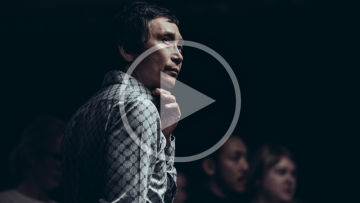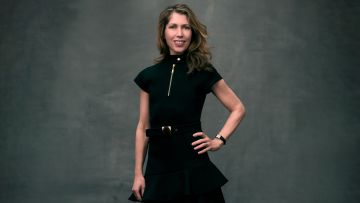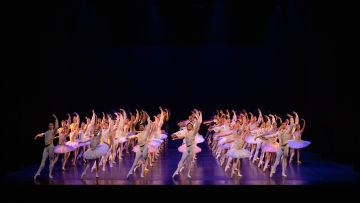Trip the light fantastic

How to light a ballet with Queensland Ballet Technical Director Cameron Goerg.
Eight to 12 hours. 16 if he’s lucky. That’s all the time QB Technical Director Cameron Goerg has in the theatre to design lighting for a ballet production that has been months in the making. Highlighting the dancers’ movements, costumes, the set designs and the music, each element of the show relies on its precision.
“The lighting designer has to create a world within the world. The set designer shapes the world physically but it’s the lighting designer’s job to illuminate everything and make sure the performance stands out,” Cameron says.
“For something like Cinderella, there are 400-plus lights; Romeo & Juliet has 13 lighting bars in it, so there’s lots of light and lots of power. I pre-plan as much as I can, knowing it will change because until you get into the theatre there’s always an element of the unknown – and of discovery, as well.”
It has been more than a decade since Cameron joined the Company full-time and he has a portfolio of grand productions to show for it, including Swan Lake, La Fille Mal Gardée , The Sleeping Beauty, and all three seasons of Bespoke. Originally from Rockhampton, he completed a Bachelor of Theatre Arts in Toowoomba before working in his hometown theatre, the Pilbeam Theatre. However, it all began much earlier, with music.
“That’s how it started. From a toddler, I had an innate interest in music, and I played in the orchestra at school - piano, flute, piccolo, sax…music was my way in. And then one year, onstage in the theatre I thought yeah, ok, they’re having way more fun over there (gestures behind),” he laughs.
“After uni I volunteered at the theatre in Rocky, and that’s the amazing thing about living in a regional centre – everyone comes to you. We had all the state and national companies tour – Queensland Theatre, Opera Australia, La Boite Theatre, Sydney Dance Company, Australian Ballet and Queensland Ballet, and you get that exposure.”
His relationship with QB really kicked off when the company began a tour with a production week at the Pilbeam Theatre. The following year they asked Cameron to go on the Carmen tour with them - and the rest is history.
Speaking of the past – historically, the lighting designer tends to be of the last creatives engaged in the production, partly due to the expense of working in the actual theatre space.
“The choreographers, set and costume designers spend months honing their work, but the lighting designer does it all in their head and then they have a couple of days usually to create their vision,” he says.
“You put it onstage, trying to get as much detail in there as possible, and then there’s a technical rehearsal with the dancers onstage where you step through the show. And it’s like you’re presenting the first draft of your novel to the world. You spend the whole time problem-solving… because you’re lighting other people’s work and you can turn it from lush, velvet love to mud really easily by using the wrong colour.
“For Swan Lake, for example, it’s about making sure it’s lit evenly across the floor because the dancers are wearing a 1.2 metre white disc and white pointe shoes and a white headpiece – it’s one of the most unforgiving shows because if there’s any inconsistency in the white, you’ll see it.”
Music and mood are other things to consider.
“Every movement, every beat of music needs to be considered. And is it morning, or midday, or dusk, or midnight?
There are mood shifts, and the score, and if it’s a fairytale ballet it needs to be a fruity, bright and colourful experience. If it’s a tragedy like Romeo & Juliet, the tone and the intensity of the scenes can shift.
“And do the sets move? How do you create a consistent backlight if there’s something else in the way? You’re also tracking the dancers’ movements, and there are backdrops flying in, and scene changes,” Cameron says.
But the job is creative, too, particularly in the contemporary field.
“Bespoke (QB’s annual contemporary season) is a playground, it’s a passion project for sure,” he says.
“The freedom I was given by Li (Cunxin) and QB when Amy Hollingsworth, who was our Creative Associate at the time, asked me to come onboard was incredible, because it was literally ‘let’s see what we can do’.
“But I still also love relighting. I love getting into someone else’s head and then trying to recreate that. But also then trying to replicate that on tour is unforgiving and arduous because you’re trying to make things happen in often less than ideal circumstances. But I get energy and motivation from it because it’s that lateral thinking and problem-solving that my brain does quite well.”
- Cassandra Houghton



